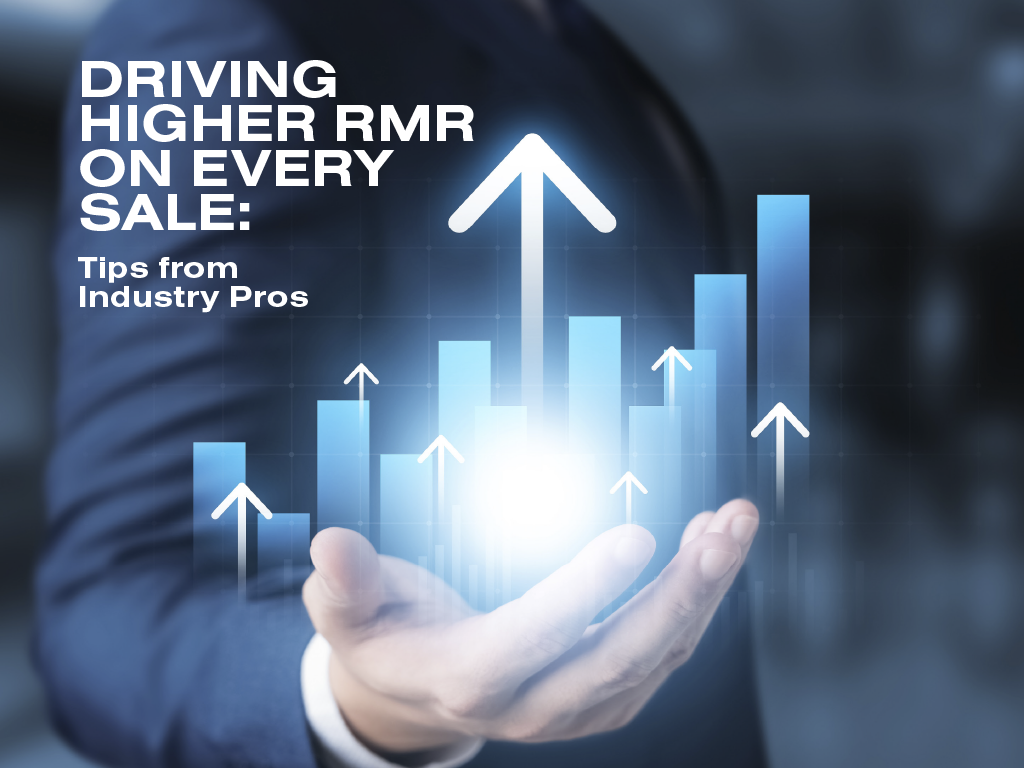Driving Higher RMR on Every Sale– Tips from Industry Pros

While having strong margins from installation revenues are vital to a security company’s health, RMR is the more sustainable business practice in the long term, supercharging enterprise value.
The “Driving Higher RMR on Every Sale” session at ESX 2023 provided more in-depth training on how company sales and technical staff can contribute to the company’s overall RMR growth.
The session was led by Resideo’s Premier Partner Program Leader, Quentin Gunther, Security Solutions’ President, Jamie Vos, and Security Pros’ Director of Client Technology, Mike Williams. Quentin brought knowledge on more of the residential and SMB side of monitoring and security, while Jamie and Mike focused primarily on the commercial side.
The three speakers brought between 20 and 30+ years of industry experience to the table as they discussed proven strategies businesses can use to grow their RMR.
The Value Proposition
The first strategy is to adjust your pricing according to what your offering is – taking into consideration not just major operations like monitoring and equipment costs, but also all the smaller services your company offers along the way, such as customer support calls. A five minute call doesn’t seem like much time, but those five minute increments add up, costing your company in time and resources. It’s important that you charge for every service that you offer if it’s of value to the customer. Otherwise, if it’s not of value to the customer, you should eliminate it completely.
Gunther, Vos and Williams have all found that setting a lump price for all the inclusions tends to reap greater RMR growth. It is more preferable for the customer to receive one bill each month, even if it’s a bit higher, versus receiving multiple bills.
Additionally, you should reduce your options. Gunther saw his sales closing ratios rise significantly when he cut down his package offerings to one or two. Too many options distract or even overwhelm the customer. If you have a single package or subscription with impressive inclusions and value offers, you will be more successful.
Therefore, it is critical to establish a value proposition behind what your company has to offer that demonstrates why it’s worth the customer’s time and money, as well as accurate pricing.
Itemize Services and Costs
Clearly listing the components of the offer and the cost of each individual item will help you fight against competition. If a customer can clearly see that your package includes equipment, installation, monitoring, and 24/7 phone support, then when a competitor shows up with a lower number but only offers equipment and installation, the customer will be able to quickly see that you have the higher value offer.
This also ensures that the customer knows exactly what they are getting and helps them take full advantage of the services. That way, they don’t find out two months in that they’ve been paying for something they haven’t been using. In the long run, this results in happier customers, who are more likely to keep returning and renew services.
Training your Sales Staff
There are some challenges that come with changing or adjusting pricing. Once you have decided on a value proposition and pricing, you must decide how to share that proposition through a fantastic story. That story should convince both your internal and external audiences, which will be your salespeople first, followed by your customers.
To convince your salespeople, you must tell a story from the customer’s perspective, helping your salespeople to relate to the customer. Encourage your staff to develop a personal connection to the customer by asking open-ended questions and involving them in a conversation versus just giving them the sales pitch. No one wants to feel like a number on somebody’s quota– your sales staff included. We have all received sales pitches before and hung up the phone before the pitch was done. Remind your staff of that regularly, training them to think from that perspective.
That said, it’s still critical to balance personal connection with efficiency and detail in the sales pitch. The customer has to understand the value of your full services and see the whole picture to understand that the cost for those services is very reasonable– and to take advantage of their full benefits. How many of us have found out after paying a monthly or yearly subscription for something that we hadn’t been taking full advantage of our included offerings because we didn’t know their extent? It’s a frustrating situation that our staff should be helping our customers avoid.
Set Goals for Your Sales Staff
Once your sales staff is ready to go, having fully understood and embraced the new mindset, it’s critical that you set sales goals. If the sales staff have no idea of what to aim for, they won’t maximize their skills, training, or time. However, if you set clear goals, they will rise to the occasion to meet them.
One important thing to note is that there should be incentives to go along with the goals. Gunther has noticed there is a direct correlation between RMR growth and sales staff that are being compensated for their achievements. You should ensure you compensate your salespeople according to what their goals are and whether they met or surpassed them.
Keep a Pulse on Your Customer Base
Companies need to keep careful track of what their clients are seeking and whether they are satisfied with their services. Make sure you are providing feedback opportunities and monitoring the responses closely, whether that is through surveys, testimonials, customer services calls, or reviews. This is a great way to track whether you are doing things right according to your customers or whether you need to make adjustments to keep customers coming back.
Inside Sales
Once you have a customer base, don’t let it go. Keeping existing customers is always easier and more cost-effective than gaining new ones. Ensure you are retargeting existing or past customers through marketing efforts, such as newsletters, promotions, etc.
Have a team that is specifically dedicated to following up with old customers or current ones. Ask questions such as “What’s changed in your business in the last x years?” or let them know about any new services or offers. For example, perhaps the customer originally came to you for surveillance cameras, but now they would like other monitoring options added as well, such as sensors. You should make that process as easy for them as possible by staying in touch and offering services before the customer has to ask or go searching for them.
You want to generate RMR as much as possible, letting your sales build on themselves rather than having to manually generate every new sale. If you apply these strategies you will see significant RMR growth over time.




